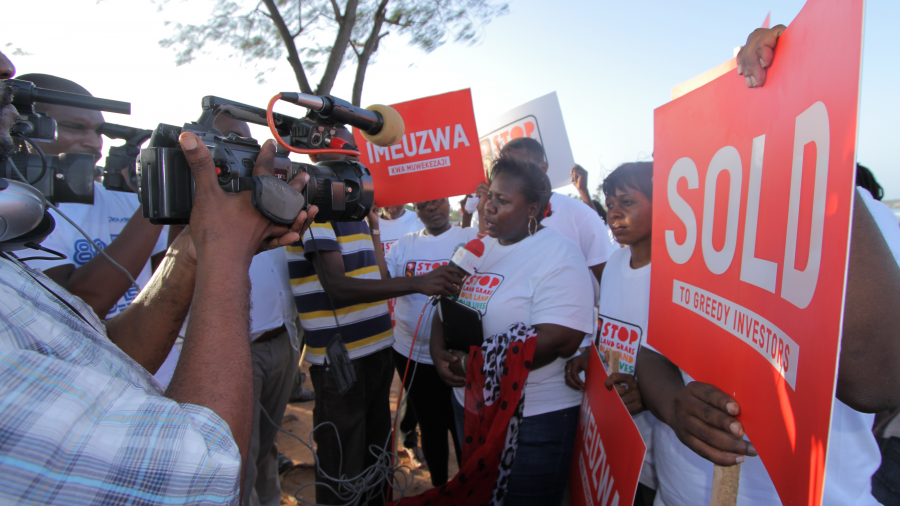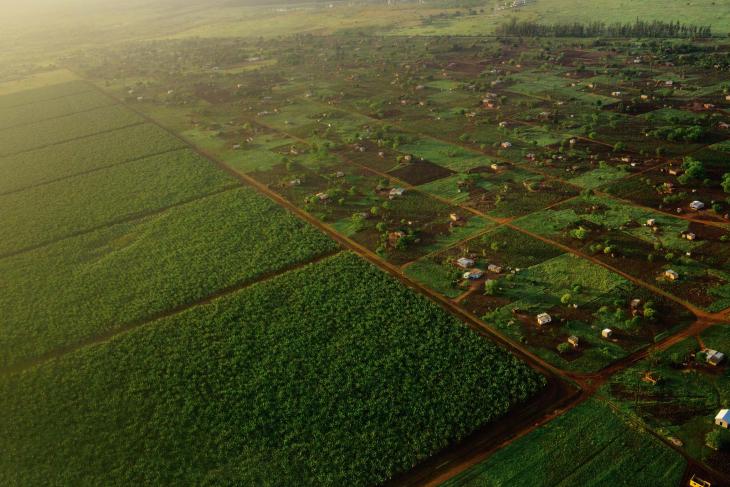
Photo Credit: Oxfam International
A downloadable version of this lesson is available here:
The acquisition or leasing of large tracts of land in the Global South by investors—both foreign and domestic—has grown dramatically. Many of these transactions represent agricultural investments in land where crop and livestock production will occur and where there is sufficient water. Indeed, water availability is often a major driver of such land purchases. Most of the acquired land, however, is in low- and middle-income countries, where indigenous peoples often govern the land and water and view them as common property. Here, farms are small-scale, low-yield holdings where products go to local markets. Investors, on the other hand, seek to make profits by increasing crop production through large-scale commercial agriculture, focusing on commodities with high-export market value. Investors often make promises up front that their investments will benefit local communities and reduce poverty by bringing new technologies and jobs; however, these claims are highly contested. If investments fail, they can leave local people with degraded land and depleted water supplies, while also displacing them to marginal lands or forcing them to migrate long distances.
Decisions over the use and sale of land at global scales, as well as their associated social and environmental impacts, are not easy to trace—transactions usually lack transparency. Thus, understanding the extent and impact of large-scale land acquisitions (LSLAs) requires detective-like research approaches in which quantitative and qualitative information together reveal patterns and stories.
This lesson involves three sessions. In this first session (Part 1) learners will work in groups to gather numeric and textual data from an open-access database about LSLAs in two countries. In the second session, learners will report out their findings to the class by answering journalistic questions; next they will explore textual material and scholarly sources to enhance their understanding of LSLAs. The third session (Part 3) gives learners time to complete their exploration of textual documents, focusing on a particular angle of interest, such as, water rights; and ends with a homework assignment to develop a well-researched, evidence-based editorial suitable for an outlet such as The New York Times.
This multi-part lesson would be further enhanced if it follows all or parts of the lessons “Introduction to Qualitative Methods for Sustainability: Narrative and Identity in Climate Beliefs" and "Governance Theory Part 1: Revising the Tragedy of the Commons."
- Understand the environmental and social dimensions of LSLAs.
- Undertake socio-environmental research using both quantitative and qualitative data to reach an evidenced-based conclusion.
- Practice writing that seeks to influence others with an evidence-based argument.
The lesson is suitable for a 50-min. or 75-min. session. Instructors should familiarize themselves with the Land Matrix website and how to navigate to the land deals section to collect data. Full instructions for use of the website are included in the PowerPoint under Teaching Assignment 1, as well as in the Handout for Participants under Teaching Assignment 3.
Additionally, as preparation for the session, the instructor should ask learners to read the highlighted sections of the two papers linked below. The Nkansah-Dwamena (2021) sections provide brief background on the topic under consideration. Participants should read the Sullivan et al. (2022) sections more carefully and take notes on them. Note: advanced graduate students and above should read the entire articles.
-
(15 min.) Review the background information and the goals of the lesson in slides 1–8 in the linked PowerPoint. (Pause at slide 8 before continuing to the next steps.)
DocumentLSLA Part 1.pptx (15.76 MB) -
(5 min.) Once at slide 8, divide the class into four or more groups with each group having no more than three people. Assign each group to one of the country pairs below. It is okay if more than one group researches a given pair.
Group 1 – Argentina & Sudan
Group 2 – Chile & Zambia
Group 3 – Uruguay & Lao People's Democratic Republic
Group 4 – Mozambique & Egypt
-
(5 min.) Distribute the LSLA Handout for Participants that is linked below. This document provides detailed instructions on the data that groups are to collect from the Land Matrix database and they will use it to follow along with next assignment.
Document -
(10 min.) Have the participants navigate to the Land Matrix website. Using the PowerPoint slides 9–11 help them select the appropriate settings for the data exercise.
-
(5 min.) Review slide 12 (participants will follow along with the research questions on the handout). At this time, simply instruct participants that the information gathered from the database will allow them to address some or all of these questions and that they may add additional questions/topics as they find information. They will formally answer the questions in the next session (part 2).
-
(10–35 min.) Instruct each group to develop a shared document in which each group member can enter data and let the data collection begin!
Note that it is assumed groups will not finish their data collection in class. Therefore, before class concludes ask each group to divide the remaining work amongst themselves and to finish entering their data for homework. In the next session they will summarize their data collection with their group-mates in the context of the key questions.
-
Taking stock of the global land rush: Few development benefits, many human and environmental risks
This text is an excellent source for the instructor as it offers a concise summary of the findings from the latest analysis of data in the Land Matrix database. For example, it provides information on the number of deals over time, failure rates, characteristics of countries where most deals occur, who owns the land that deals typically target, impacts on governance, extent to which promises are fulfilled, etc.
Lay, J., Anseeuw, W., Eckert, S. et al. (2021). Taking stock of the global land rush: Few development benefits, many human and environmental risks. Analytical Report III. Centre for Development and Environment, University of Bern; Centre de coopération internationale en recherche agronomique pour le développement; German Institute of Global and Area Studies; University of Pretoria; Bern Open Publishing. https://doi.org/10.48350/156861
-
Contesting large-scale land acquisitions in the Global South
This article is relevant to the lesson to emphasize to learners that small farm holders subjected to LSLAs are not just passive “recipients” of impacts. Many people from the affected regions are very active in protests, work to retain land rights, and fight for profits to be shared with locals.
Sändig, J. (2021). Contesting large-scale land acquisitions in the Global South. World Development, 146, 105581. https://doi.org/10.1016/j.worlddev.2021.105581
-
Who are the losers? Gendered-migration, climate change, and the impact of large scale land acquisitions on food security in coastal Tanzania
The authors take a political ecology research approach to explore who is impacted by food insecurity when LSLAs occur in the face of changing climates. It is useful for instructors who may want to introduce this approach to learners and/or reveal the important differences by gender and by climate migration status.
Atuoye, K.N., Luginaah, I., Hambati, H. et al. (2021). Who are the losers? Gendered-migration, climate change, and the impact of large scale land acquisitions on food security in coastal Tanzania. Land Use Policy, 101, 105154. https://doi.org/10.1016/j.landusepol.2020.105154
